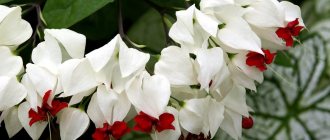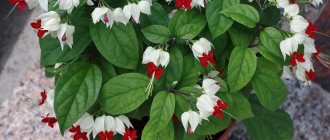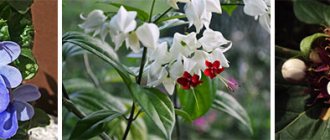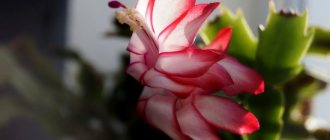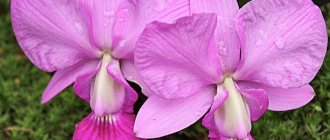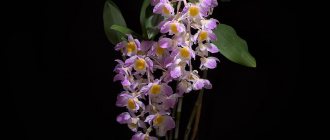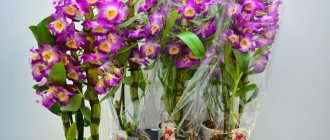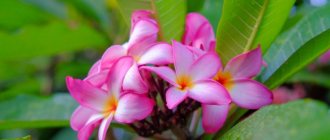Clerodendrum Ugandan grows not only in the Rwenzori Mountains, which rise in the western part of East Africa, but also decorates the window sills of apartments and country houses in mid-latitudes.
The tropical plant is called the tree of destiny. There is a legend that it brings good luck and happiness.
The leaves and flowers of almost all types of shrubs and vines that occupy their place in the Verbenov family have a unique and not very pleasant aroma.
Description
is popularly called “blue butterflies” due to the butterfly-shaped flowers The length of the leaves can reach 10 cm, the color of the leaves is dark green, thin woody shoots can reach a length of 2.5 m. The flowering period lasts from spring to autumn, the leaves have a bluish tint.
You can also find other types of Clerodendrum on our website: Clerodendrum Wallich, Clerodendrum Thompson, Clerodendrum Philippine.
Photo
You can clearly see the Clerodendrum Ugandan in the photo:
What kind of variety?
The plant has the following qualities:
- grows quickly;
- the stems quickly become woody;
- in winter the flower sheds its leaves;
- vines and various branches grow rapidly;
- the flowers are heart-shaped with bright red corollas.
Known varieties of the plant are After blooming and Albo marginata. The first is famous for the light purple color of the stipule, the second for the superiority of the light yellow tone over green. Each of the representatives of clerodendrum is unique and beautiful in its own way. We invite you to familiarize yourself with information about such flower varieties as Ugandan, Philippine, most beautiful, brilliant, speciosum, inerma, Prospero, Wallicha and Bunge.
Home care
If you decide to get a Ugandan clerodendrum, caring for it at home will not be difficult. It is best to place the flower in southern directions; in spring and summer it is recommended to place the plant on the loggia, during this period the most favorable conditions are created for it.
The northern direction is considered the worst for clerodendrum; there may be problems with the appearance of flowers; to improve conditions, it is necessary to use additional lighting with phytolamps.
Read more about caring for Clerodendrum here.
Trimming
Pruning is considered a necessary procedure; it helps maintain the active growth of clerodendrum and increases its bushiness.
This factor also determines the time of pruning, which is recommended to be done in spring or autumn - before and after flowering. During the procedure, the shoots are shortened .
Pruning allows you to form the crown not only as a vine, but also in the form of a standard tree; for this purpose, the lower branches are removed from one central shoot, resulting in the formation of a smooth trunk of a certain height.
The crown is obtained as a result of constant pruning and pinching of side shoots. This method gives the stem support, as a result of which the plant does not bend or break.
Watering
It is recommended to water the plant moderately and regularly , after the soil dries out, since waterlogging poses a great danger to the roots of the flower. In winter, it is recommended to water clerodendrum less often; complete drying of the soil is not allowed.
The flower absorbs water over its entire surface; it is very important to spray the plant regularly. Water procedures are also useful due to the increased dryness of the air; when spraying, melt or rain water is used.
Landing
Slightly acidic humus soils are used for cultivation; this can be sand, peat, humus, leaf and turf soil mixed in equal proportions. You can buy slightly acidic soil for begonias and roses in the store. It is recommended to put a layer of drainage at the bottom of the pot to prevent water from stagnating; before planting, the soil must be disinfected, which will protect the flower from fungi or pests.
Transfer
Sometimes the frequency of flower transplantation can reach 2 times a year. When choosing a pot, you must take into account that the larger it is, the faster the flower will grow. At the bottom of the flowerpot it is necessary to lay a layer of drainage 3-4 cm, this can be expanded clay, particles of brick, shards.
After this, you need to fill the new pot with soil, remove the flower, trim the shoots, and replant using the transshipment method, which will prevent damage to the root system.
Lighting
One of the prerequisites for flowering is a large amount of light ; clerodendrum is not afraid of direct sunlight.
Temperature
Temperature an important condition for normal flower growth.
In summer, the plant feels good at moderate temperatures; in winter, the optimal temperature regime is 12-16 degrees.
If this rest is not observed, optimal conditions for dormancy will not be provided, which can have a negative impact on the flowering process.
How to prune
The ends of the sprouts are pinched during the procedure. Volkameria can become a flexible vine, bush, or tree. Pruning rejuvenates the plant, increases decorativeness and makes young shoots bloom.
Remove shoots, dry, diseased, damaged shoots throughout the growing season. If the trimmed parts have two growth parts, they can be used in cuttings.
If clerodendrum grows in open ground, the bushes are pruned and additional supports are made for the vines. To form a trunk, the strongest stem is selected and the lateral shoots are cut off. When the height reaches 50 cm, pruning is carried out, and then young shoots are pinched.
This is how a beautiful tree is formed, from which the lower shoots starting from the root collar are regularly trimmed.
Reproduction
By cuttings
Propagation is carried out by cuttings and seeds; cuttings are recommended to be carried out in the warm season; in winter the process is slower. Sufficiently strong cuttings are recommended to be transplanted into separate pots.
To obtain a lush bush, you should take 2-3 pieces; to form the crown of the plant, you must periodically pinch it.
Seeds
Seed cultivation is carried out in the usual way - seeds are planted in the spring, and when sprouts appear, they are planted in large containers.
Diseases and pests
Ugandan clerodendrum can also be affected by diseases and pests; the most common is rot , the occurrence of which is associated with improper or excessive watering.
The plant suffers from whitefly and spider mites ; the former can be removed mechanically by wiping the leaves. Spraying with a soap solution will help destroy spider mites.
Aphids pose a great danger to the flower ; insecticides will help fight them; the most affected areas must be removed.
Why doesn't it bloom?
The absence of flowers in the prescribed period is due to a violation of the rules for maintaining clerodendrum in the winter.
Winter plays an important role, during which the plant must regain strength for the upcoming flowering.
Preparation must begin in the fall when shoot growth slows; watering during this period should be reduced and fertilizing should be stopped.
For winter, the plant is placed in a cool room, with an air temperature of at least fifteen degrees.
At this time, clerodendrum may completely lose its leaves; it is not recommended to be afraid of this - the process is completely natural. If normal conditions for winter are created, problems with flowering should not arise. Another problem with the lack of flowers is the lack of lighting.
Difficulties in growing
With the right conditions at home and proper care, Ugandan clerodendrum will delight you with beautiful flowering. But if some mistakes were made in care, then some problems may arise during cultivation.
The most common problems and how to deal with them:
- Clerodendrum does not bloom - lack of sunlight. It is necessary to move the pot to a brighter place.
- Leaves fall - the air in the room is too dry. Regular watering and spraying of the shoots will help.
- Pale leaves with dry tips indicate too hard water. Use filtered water for irrigation.
- There are brown spots on the leaves - the room is too cold. It is necessary to move the flower to a warmer place.
Did you know? On the island of Java there is a belief that clerodendrum brings good luck to young girls and women, and on the African continent it is used in wedding ceremonies.
Why doesn't it bloom
The reason that clerodendrum does not bloom may be a room that is too dark or cold, a lack of fertilizer, or improper pruning. The inflorescences appear at the tops of the shoots; if excessive pruning occurs, the flower stalks can also be removed. The key to lush flowering is a mandatory 2-3 month rest period in late autumn - early winter, at a temperature of +15°C. After rest, the clerodendrum will bloom to its full potential.
Diseases and pests
If you water too much or have poor drainage, clerodendrum can develop root rot. The root system affected by the disease rots and the plant may die. It is necessary to remove the affected roots, replant the flower in fresh, disinfected soil and do not overwater it in the future. Clerodendrum leaves contain essential oils that repel many insects.
But still he has enemies who can cause harm:
- spider mite – a thin cobweb appears on the leaves, they turn yellow and fall off;
- whitefly – on the inside of the leaves there are many small white flies, about 2 mm long, they feed on the sap of the plant. The leaves turn pale, yellow spots and small holes appear on them;
- aphid – the plant grows poorly, the buds and shoots curl, there are small insects on the inside of the leaves.
A warm shower and treatment with an insecticide such as Actellik or Microcin will help destroy pests on the leaves.
Find out more about other types of clerodendrum: Philippine and Thompson.
So, we can conclude that caring for a tropical “tree of destiny” is no different from caring for most indoor plants. Anyone can grow this magnificent flower, provided that they have a bright and warm corner at home. It is enough to follow all the recommendations and avoid gross mistakes in care, and your home will be filled with the pleasant aroma and beauty of blue butterfly flowers all summer long.


